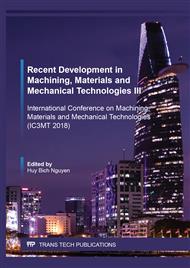[1]
E. Brinksmeier, J.T. Cammett, W. König, P. Leskovar, J. Peters, and H.K. Tönshoff, Residual Stresses - Measurement and Causes in Machining Processes, CIRP Annals, Vol. 31 (1982) pp.491-510.
DOI: 10.1016/s0007-8506(07)60172-3
Google Scholar
[2]
Y. Murakami and H. Ibuchi, Residual Stresses due to the Milling Operation, J. of Material, Vol. 16, No. 171 (1967) pp.966-971.
DOI: 10.2472/jsms.16.966
Google Scholar
[3]
E. Capello, Residual stresses in turning Part I: Influence of process parameters, J. of Materials Processing Technology, Vol. 160 (2005) pp.221-228.
DOI: 10.1016/j.jmatprotec.2004.06.012
Google Scholar
[4]
E. Capello, Residual stresses in turning: Part II. Influence of the machined material, J. of Materials Processing Technology, Vol. 172 (2006) pp.319-326.
DOI: 10.1016/j.jmatprotec.2005.10.009
Google Scholar
[5]
T. Shirakashi, T. Obikawa, H. Sasahara, and T. Wada, The Analytical Prediction of the Characteristics within Machined Surface Layer (1st Report), J. of the Japan Society for Precision Engineering, Vol. 59, No. 10 (1993) pp.1695-1700.
DOI: 10.2493/jjspe.59.1695
Google Scholar
[6]
T. Shirakashi, T. Obikawa, H. Sasahara, and T. Wada, Effect of Tool Condition on Residual Stress Distribution within Machined Sublayer, J. of the Japan Society for Precision Engineering, Vol. 59, No. 12 (1993) pp.2003-2008.
Google Scholar
[7]
H. Sasahara, T. Obikawa, and T. Shirakashi, The Analytical Prediction of the Characteristics within Machined Surface Layer (Part 3), J. of the Japan Society for Precision Engineering, Vol. 60, No. 12 (1994) pp.1801-1805.
DOI: 10.2493/jjspe.60.1801
Google Scholar
[8]
M. Mohammadpour, M.R. Razfar, and R.J. Saffar, Numerical investigating the effect of machining parameters on residual stresses in orthogonal cutting, J. of Simulation Modelling Practice and Theory, Vol. 18 (2010) pp.378-389.
DOI: 10.1016/j.simpat.2009.12.004
Google Scholar
[9]
H.A. Eltawahni, M. Hagino, K.Y. Benyounis, T. Inoue, and A.G. Olabi, Effect of CO2 laser cutting process parameters on edge quality and operating cost of AISI316L, J. of Optics & Laser Technology, Vol. 44 (2012) pp.1068-1082.
DOI: 10.1016/j.optlastec.2011.10.008
Google Scholar
[10]
Eltawahni, H.A., Olabi, A.G., Benyounis, K.Y., Effect of process parameters and optimization of CO2 laser cutting of ultrahigh-performance polyethylene, J. of Materials & Design Vol. 31. No. 8 (2010) p.4029–4038.
DOI: 10.1016/j.matdes.2010.03.035
Google Scholar
[11]
Eltawahni, H.A., Olabi, A.G., Benyounis, K.Y., Investigating the CO2 laser cutting parameters of MDF wood composite material, J. of Optics and Laser Technology, Vol. 43, No. 3 (2011) p.648–659.
DOI: 10.1016/j.optlastec.2010.09.006
Google Scholar


